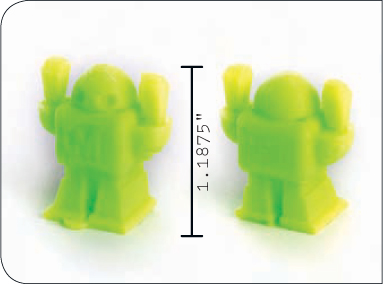CUBE 2
3D SYSTEMS / CUBIFY.COM
Safe and easy to use, but a closed system holds back its potential.
![]() Price as tested $1,299
Price as tested $1,299
![]() Print volume 5½″×5½″×5½″
Print volume 5½″×5½″×5½″
![]() Heated bed? No
Heated bed? No
![]() Print materials PLA, ABS
Print materials PLA, ABS
![]() OS supported Mac, Windows
OS supported Mac, Windows
![]() Print untethered? Yes, over wi-fi or via USB flash drive
Print untethered? Yes, over wi-fi or via USB flash drive
![]() Open-source hardware? No
Open-source hardware? No
![]() Open-source software? No
Open-source software? No
![]() Printer control software Cube software
Printer control software Cube software
![]() Slicing software Cube software
Slicing software Cube software

Last year we reviewed 3D Systems’ entry into the desktop 3D printer market, the Cube. It was a relatively affordable, compact, simple-to-use printer that used closed-source software and proprietary filament cartridges. These elements made this printer less appealing to 3D printing veterans, but great for young or inexperienced makers who want to venture into the world of 3D printing.
This year 3D Systems released the Cube 2, adding a few modifications that make it even safer, quieter, and more kid-friendly, in hopes of better meeting the needs of the education market. Unfortunately the price paid for these changes is reduced print quality.
Very Easy Setup, Nice Touchscreen Features
The Cube 2 is very easy to set up. The required software can be downloaded from cubify.com and supports both Mac and Windows (sorry, Linux users). After installation, a simple graphical interface walks you through the steps to prepare a 3D model for printing. The software also includes a “heal” option that will fix flaws in the selected model to make it print-ready.
The software lets you make some basic changes, such as scaling and orientation of the model, before exporting the model to the provided thumb drive, which can be used to print without the need for an attached computer. The Cube also includes a built-in wireless network that allows models to be sent to the printer over wi-fi.
The built-in touchscreen interface allows you to quickly access useful features like bed leveling, nozzle calibration, and filament loading/unloading. (The Cube uses proprietary cartridges, making its filament more expensive than other printers.) With the thumb drive plugged into the printer, you can select the model you wish to print and start the process from the touchscreen.
Quieter and Safer Than Last Year, but Print Quality Suffers
The first thing we noticed when the printer fired up was the motors used in this version of the Cube are significantly quieter than those in last year’s model. This version also sports a silicone bumper around the extruder nozzle, which helps protect any curious fingers from being burned by the hotend. It also keeps stray filament from coiling up and sticking to the nozzle, a common problem in other printers.
3D Systems has included a magnetically attached glass build platform; the lack of a heated build platform adds one more level of safety, but means the Cube needs a little more help getting prints to stick to the build plate. This help comes in the form of CubeStick glue, a solution that’s applied to the glass plate with the included squeegee bottle. This is easily the most tenacious grip we’ve seen of any print to a platform. Once the print is complete, the glue dissolves in water, allowing the print to pop right off the build plate surface.
The finished print quality, however, has considerable downsides when compared to printers in the same price range. Overhangs and caps showed significant drooping, small details were lost, and the prints frequently feature a small pool of plastic on the edge of the model where the extruder started the print and placed an anchor within the print itself.
Most of the issues that we experienced were caused by the slicing software and not by hardware, meaning that with a little bit of work and a software update, this machine could be cranking out the kind of prints we would expect from it. Unfortunately since the software is closed source, users won’t be able to make these changes themselves.
Conclusion
3D Systems has taken a lot of care to design a printer that can be used in educational settings without the usual safety concerns that come with most 3D printers. Parents looking to purchase a printer for a young maker will be happy with the simplicity of use in addition to these safety features. More advanced users will quickly find that the closed nature of the Cube 2 and its disappointing print quality makes this not the printer for them. ![]()
![]() Print over wi-fi or from USB flash drive.
Print over wi-fi or from USB flash drive.
![]() Touchscreen interface
Touchscreen interface
![]() Magnetically attached build platform for easy removal
Magnetically attached build platform for easy removal
![]() CubeStick glue creates a sure-thing bond to your platform.
CubeStick glue creates a sure-thing bond to your platform.
Young Makers, Educators, Beginners
![]() Soak the build platform in water to dissolve the magic CubeStick glue.
Soak the build platform in water to dissolve the magic CubeStick glue.
![]() Touchscreen interface allows you to level the bed and adjust nozzle height.
Touchscreen interface allows you to level the bed and adjust nozzle height.
![]() The built-in wireless network sets up as an “ad hoc” hotspot so you can print wirelessly on the go.
The built-in wireless network sets up as an “ad hoc” hotspot so you can print wirelessly on the go.
With a little bit of work and a software update, this machine could be cranking out the kind of prints we would expect from it.

HOW’D IT PRINT?

